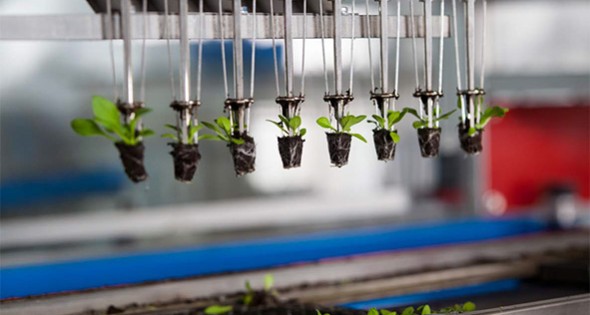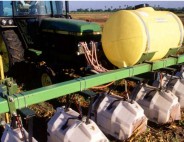
Planting Seeds to Reap the Harvest of a Digital Future
23 May, 2018
Agribusiness is using drones and other internet collaborations for more production efficiencies.
The agribusiness in this country and around the world has been relatively conservative about economic growth. It’s still a solid investment, and the growth has been slow and steady.
But there has been some decline especially in the U.S., where more attention is being paid to organically, locally grown crops, and consumers are turning away from the legacy products that helped the industry grow, such as whole milk, to other non-dairy products that look or taste like milk.
But like almost every industry in the world – and especially in the U.S. – agribusiness is beginning to adjust to new consumer demands while seeking assistance in food production from new technologies that help advance plant science, monitor crops better than ever before, and even robotically tend to crops as they grow.
First, let’s take a look at the total food business stats both globally and in the U.S. for a base of understanding about where the industry is today and where it’s going tomorrow.
THE GLOBAL MARKET – SIZE AND TRADE
Data from the United States Department of Agriculture (USDA) shows that, in a world of over 7.4 billion people and approximately 200 countries, there are more than 500 million farms.
According to a report by McKinsey and Company, a global management consulting firm, the size of the global food and agribusiness market right now is $5 trillion. Since 2004, corporate and venture-backed investments focused on the food and agribusiness sector have grown significantly, tripling to more than $100 billion in 2013.
Exports of U.S. food and farm products totaled $135 billion in 2016, according to the USDA, then rose to $140.5 billion in 2017 – the third highest level on record – with 95 percent of the world’s consumers living outside of the U.S.
Most of those consumers were Chinese. The USDA reported that, in 2017, China was the United States’ largest export customer, with shipments valued at $22 billion, followed closely by Canada at $20.4 billion.
U.S. agricultural exports to Mexico reached $18.6 billion in 2017, a six percent gain from the previous year, while exports to Japan grew 12 percent, to $11.8 billion. Rounding out the top 10 markets for agricultural exports were the European Union ($11.6 billion), South Korea ($6.9 billion), Hong Kong ($4 billion), Taiwan ($3.4 billion), Indonesia ($3 billion) and the Philippines ($2.6 billion).
U.S. AGRI-STATS
According to data from the USDA, agriculture, food and related industries contributed $992 billion to U.S. gross domestic product (GDP) in 2015.
In 2016, 21.4 million full- and part-time jobs were related to the agricultural and food sectors, which was 11 percent of total U.S. employment. Direct on-farm employment accounted for about 2.6 million of these jobs, or 1.4 percent of U.S. employment.
With a 12.6 percent share, food ranked third behind housing (33 percent) and transportation (15.8 percent) in a typical American household’s 2016 expenditures.
GROWING THE U.S. FAMILY FARM
The steady growth of the industry means that finding other resources to manage and scale up farms has become increasingly important, especially since most farms are family owned and operated running on tight margins, making them more susceptible to anything that increases operational costs.
In fact, 90 percent of U.S. farms are small, and these farms accounted for 51 percent of the land operated by farms in 2016, according to the USDA. Large-scale family farms accounted for the largest share of production, at 45 percent.
Large-scale family farms account for half of hog production and two-thirds of both dairy production and high-value crops like fruits and vegetables. Midsize and large-scale family farms dominate cotton (83 percent of production) and grains/soybeans (74 percent). Small farms produce 59 percent of U.S. poultry output and 50 percent of hay.
FOCUS: DAIRY
According to a report from the International Food and Agribusiness Management Review (IFAMR), “Dairy Export Markets – Changing the Structure of U.S. Dairy Demand,” the U.S. dairy industry is an attractive target for foreign investment of various kinds.
For example, both Hilmar Cheese Company, based in Hilmar, California, and specializing in the production of cheddar and American-style cheeses, and Leprino Foods, based in Denver, Colorado, and one of the largest mozzarella cheese makers in the world, made major investments in building dairy product capacity after 2000 to attract both a larger foreign consumer base and foreign investors.
In 2015, the U.S. food and beverage manufacturing sector employed more than 1.5 million people, or just over 1 percent of all U.S. nonfarm employment.
Dairigold, one of the largest dairy co-ops in the country making milk, butter, sour cream and cream cheese, added dry whole milk production capabilities to its operations during renovation of its manufacturing facilities in 2013 to meet the demand growth in international markets.
FOCUS: BEEF
In 2012, sales of cattle and calves in the United States totaled $76.4 billion, a 25 percent increase since 2007, when the agriculture census was last conducted. Although every state has cattle production – Texas, Kansas and Nebraska are the top three – the top ten states accounted for 73 percent of sales.
Statistics from the National Cattleman’s Beef Association show that the amount of beef consumed in the U.S. in 2016 was 26 billion pounds. Japan remains the biggest market for beef exports – the Japanese spent $1.5 billion on 260,000 metric tons of beef – followed closely by Mexico, spending $975 million on 242,000 metric tons.
FOCUS: FOOD AND BEVERAGE
In 2015, the U.S. food and beverage manufacturing sector employed more than 1.5 million people, or just over 1 percent of all U.S. nonfarm employment.
According to the Census Bureau’s 2012 census, there are over 30,000 food and beverage processing plants in the U.S. owned by about 25,800 companies in 2012. These plants employed more than 1.5 million workers in 2015 (about 14 percent of all U.S. manufacturing employment and just over 1 percent of all U.S. nonfarm employment).
The meat processing industry employed the largest percentage of food and beverage manufacturing workers in 2015 (31 percent), followed by bakeries (16 percent), and fruits and vegetables (11 percent).
According to the Census Bureau, California had the most food and beverage manufacturing plants (5,531) in 2015, while New York (2,508) and Texas (2,175) were also among the top leading food and beverage manufacturing states.
The largest food and beverage manufacturing cluster in North America is the Northwest Food Processors Association (now called Food Northwest) based in Portland, Oregon, with 152 processor companies and more than 350 supplier members.
DISRUPTIVE TECHNOLOGIES COMING INTO PLAY
There is disruptive change occurring in the agribusiness, part of which is internet-based technology that uses larger and larger collections of data.
While industry analysts continue to work out a business model that captures value from data at scale – a job made more difficult because the data is coming from different parts of the value chain (for example, seed companies, equipment manufacturers, traders, and software developers) – some companies are working to capitalize on that movement.
For example, Monsanto’s $930 million acquisition of San-Francisco-based The Climate Corporation in 2013 was one of several moves by a major U.S. agriculture company. The Climate Corporation is a digital agriculture company that examines weather, soil and field data to help farmers determine potential yield-limiting factors in their fields.
Moves like this are helping the industry focus on data analytics for precision agriculture, also known as site-specific crop management, which involves collecting and analyzing information at the individual botanical plant level for improved agricultural practices, according to the Stanford Business white paper, “Technology in Agribusiness: Opportunities to Drive Value.”
A study of 3,380 American farmers found that those implementing site-specific crop management technology reported an average cost reduction of 15 percent, and an increase in average yields of 13 percent.
Other new agri-technologies being used now include crop monitoring by drones and satellites that show irrigation problems, soil variation, deforestation, changes in livestock, soil erosion, pest and fungal infestations.
The Stanford Business white paper noted that as the quantity, quality, speed, and flow of data improves, data analytics platforms and machine learning applications can enable better practices in farming, processing, and manufacturing.
That sort of broad accumulation and application of data is precisely the business of Farmers Business Network (FBN), a membership-based online platform for farmers to share performance data and conduct analytics that can improve productivity.
It provides farmers with smartphone applications showing the largest seed performance database, average market prices on a wide selection of inputs (such as fuel and herbicides), field activity tracking, plus data storage and integration.
One example of robotics in agribusiness is the LettuceBot from Blue River Technology, a technology startup in Sunnyvale, California, founded by two Stanford graduate students in 2011, which uses “see and spray” technology – integrated computer vision and machine learning/ technology to allow growers to reduce the use of herbicides by spraying only where weeds are present. The company was bought by John Deere for $305 million in 2017.
A NEW WILD CARD
Economic developers tracking what is happening in agribusiness also have a new wild card in the deck – the cannabis crop. New ways of growing this cash crop using methods developed by Dutch tulip growers, and deeper dives into the genome of the plant using better analytics for researchers, are helping this nascent business rocket to new heights. Colorado alone recorded $1.7 billion in sales of cannabis in 2017 – just one of nine states where recreational cannabis is legal in the U.S.
Related Posts
-

Pinellas County, Florida Celebrates Ribbon Cutting of the ARK Innovation Center Business Incubator
-

Time To “Pivot, Stretch, And Adapt”
-

More Efficient Agriculture Techniques are Coming into the Focus
-

Logistics Getting on a Quicker, more Focused Track
-

Opportunity Zones and Post-COVID-19 Economic Recovery
-

New Ideas Emerge for Both Sustainable and Fossil Fuel Technologies
-

New Goals and New Internet Tech Help Build Base for Advanced Manufacturing
-

Business Services Today Focus on Human Resources, Data Analytics
-

Ready to Shift into High Gear
-

The New Forestry Momentum












